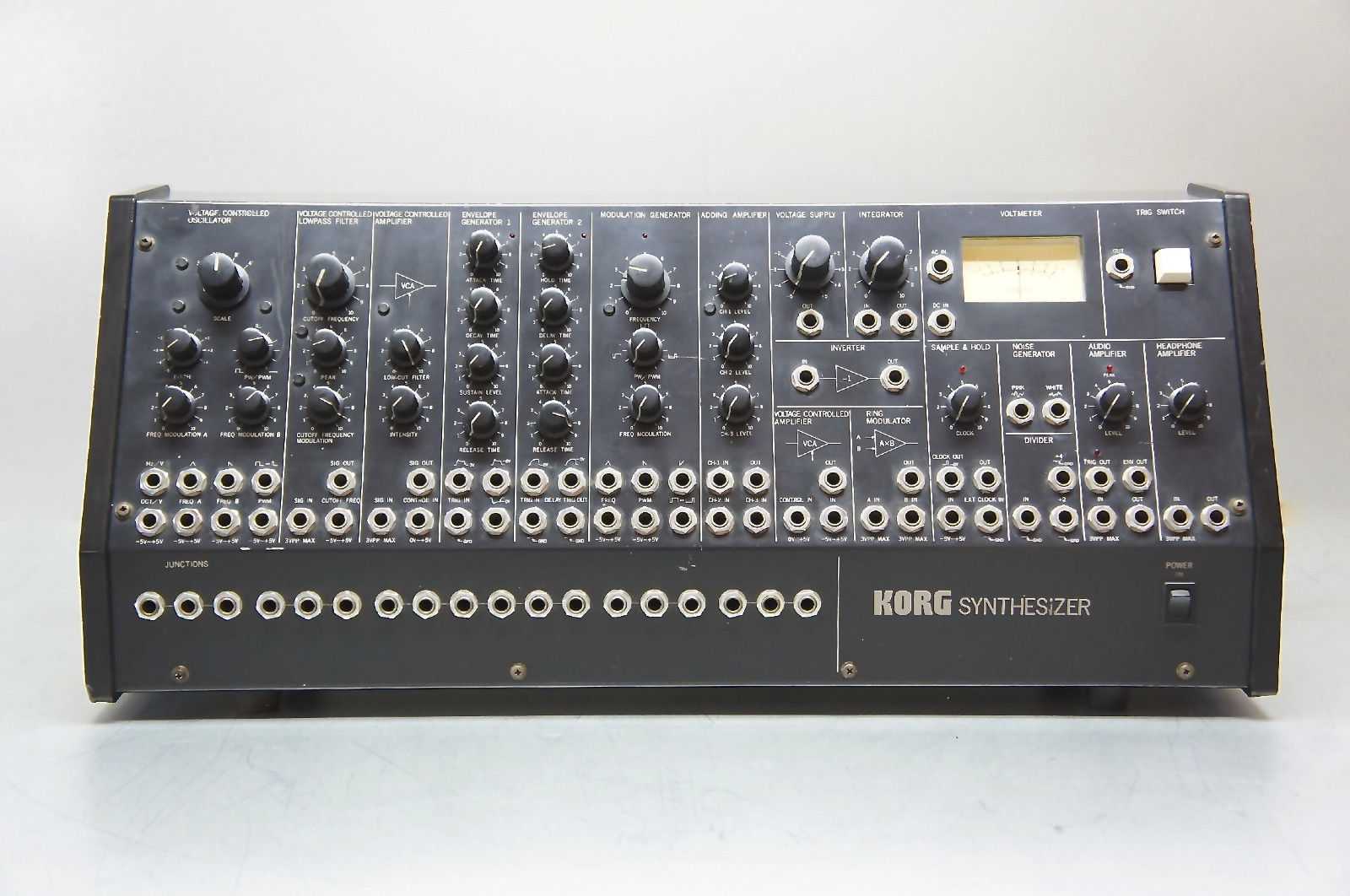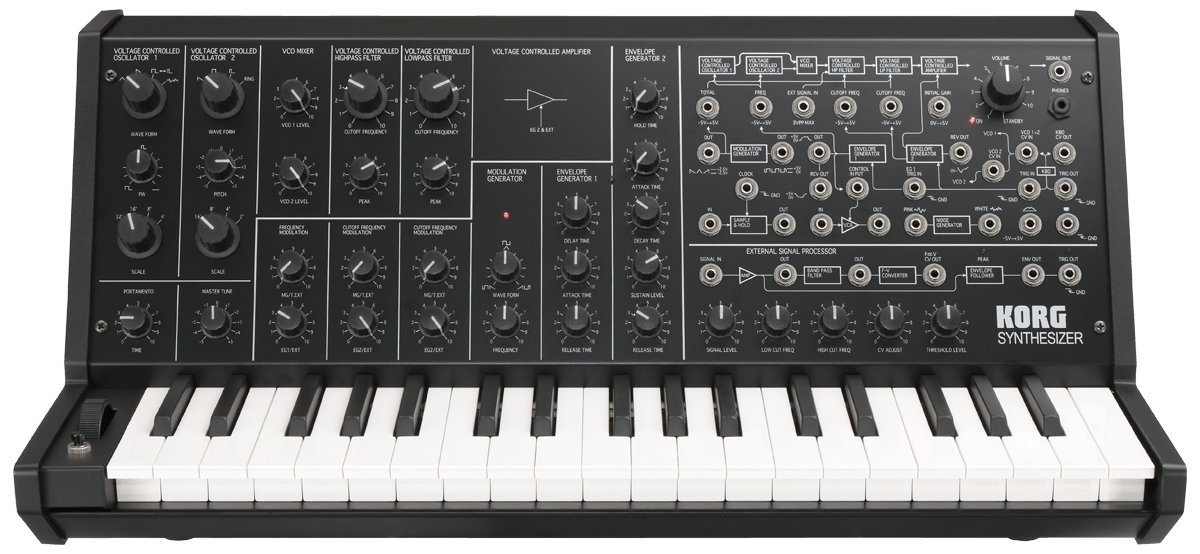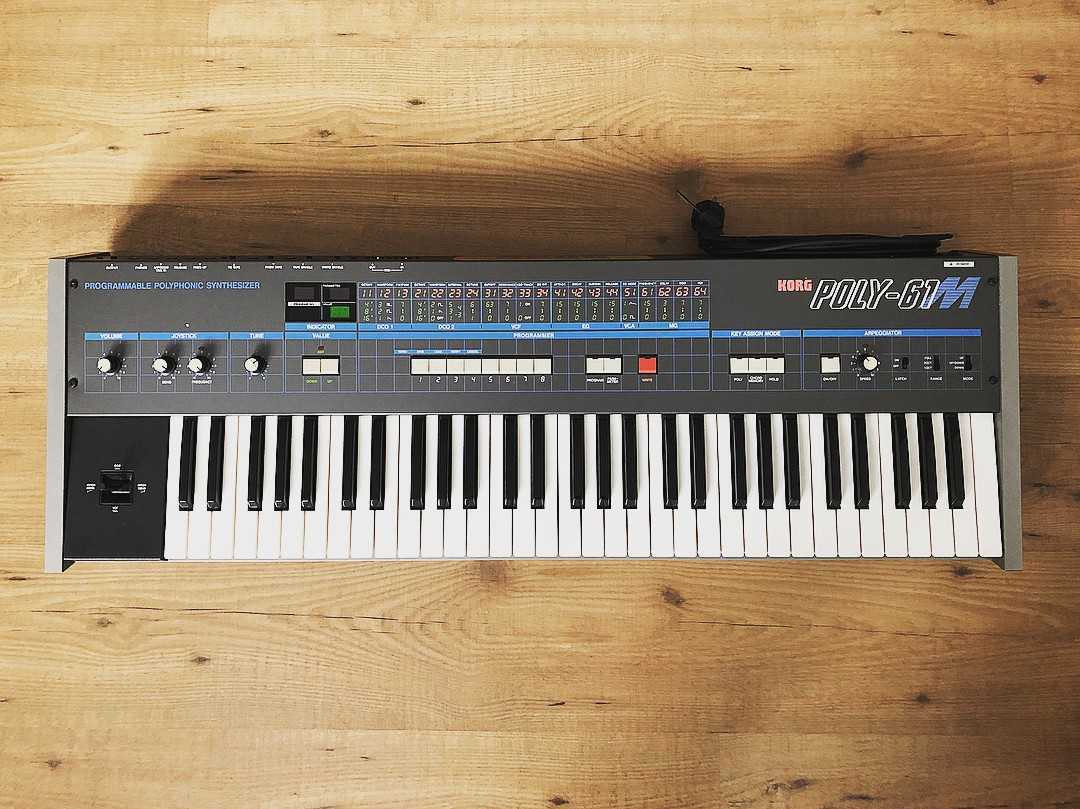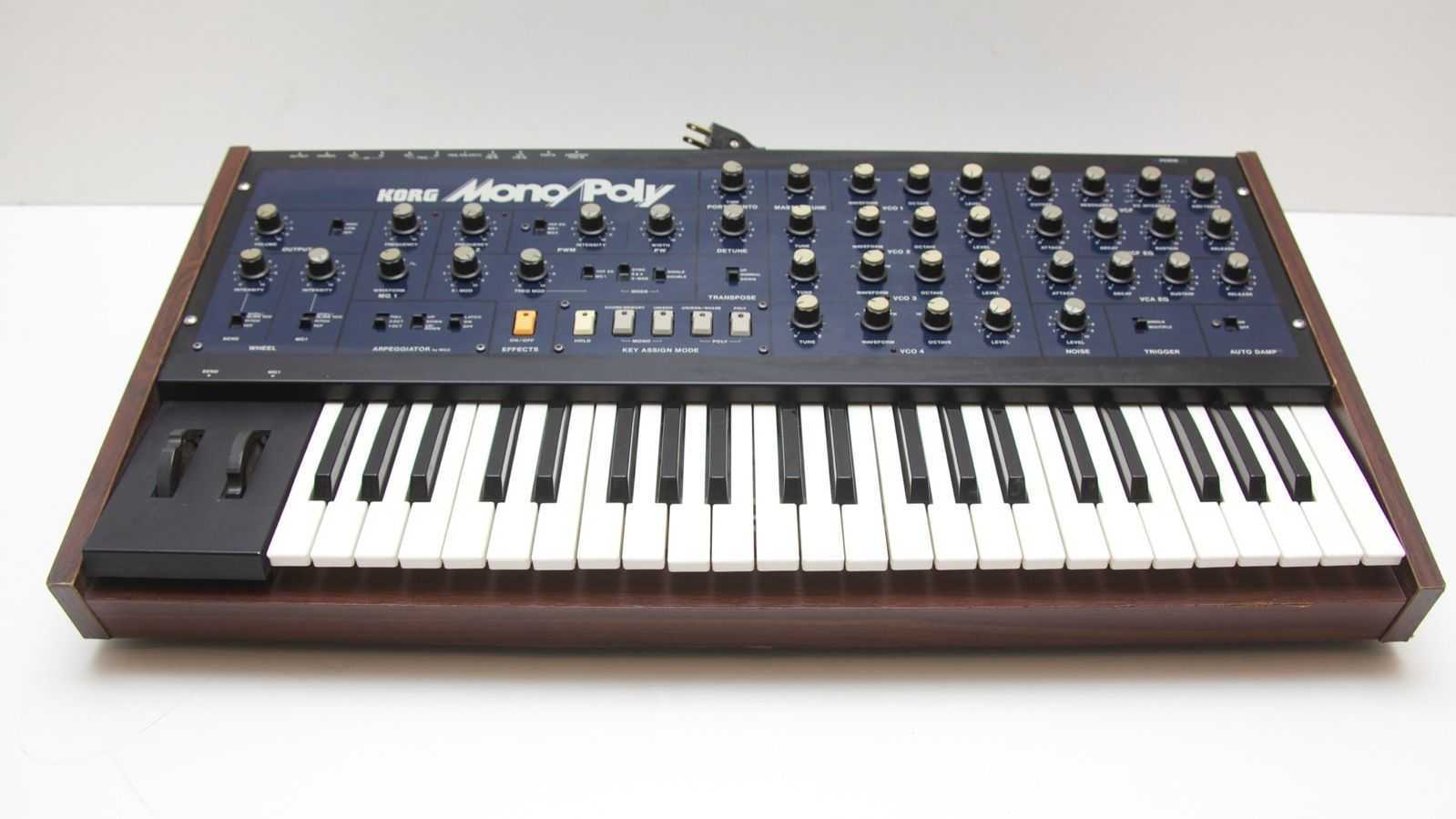
The Korg Mono/Poly is a 44 key “mono-polyphonic” analog synthesizer manufactured by Korg from 1981 to 1984. This keyboard is the sister synthesizer to the Korg Polysix. It has four highly stable voltage-controlled oscillators (VCOs), a 4-pole, self-oscillating low pass filter (LPF), several modulation capabilities and pseudo-polyphony (paraphony).
Features and architecture
Features include four voltage-controlled oscillators (VCOs) with tuning, footage (16, 8, 4, 2), waveshape (triangle, saw, pulse-width, and pulse-width modulated), and amplitude. The first oscillator is the master oscillator as far as fine tuning goes. Two direct modifiers to the VCOs are a detune control that only affects oscillators 2 and 4, and a Pulse Width control that goes to cancellation either side of 50% phase symmetry of a square wave; pulse width can be routed to MG1, MG2, or voltage-controlled filter (VCF) envelope.
There is one independent noise generator with an amplitude control (frequency and shape is modified by the VCF). There is one 24/db octave exponential low-pass VCF with resonance, scaling and invertible envelope control shared across all four VCOs. One voltage-controlled amplifier(VCA) envelope with triggering and dampering controls is shared across all four VCOs. There are two low frequency modulators: MG1 controls VCO Pitch/Pulse-width, ‘EFFECTS’ and VCF cutoff; MG2 controls the tempo of the arpeggiator, and Pulse-Width.
There is one arpeggiator with on/off/latch control, up/down/up-down pitch control, and 1/2/full keyboard control (44 notes). The arpeggiator can cycle through each oscillator in POLY mode, or all four at a time in MONO. There is an ‘EFFECTS’ section which includes VCO frequency modulation (X-MOD) with hard-sync control, and a frequency modulator with which the frequency of the modulator can be altered by the VCF envelope or MG1. For both modulators there is the option of single modulation of all oscillators, or two carriers, and two modulators (using the VCOs).
Controller Interfaces are external inputs/outputs for CV/Trigger, VCF and VCO mod inputs, arpeggiator, portamento, and the pitch/MG1 mod wheels can be assigned to control VCO1 pitch, pitch or the filter. Bender goes to 2.5 octaves +/- for Pitch and full range for VCF cutoff. There are 5 different oscillator assignment modes: ‘Hold’ drones the oscillators until force dampered or Chord Memory is activated; ‘Chord Memory (MONO)’ allows 2-4 oscillators (VCOs) to be set to any arrangement across 44 keys (for example, in organ or rave chords); ‘Unison (MONO)’ stacks all 4 oscillators; and ‘Unison/Share’, which defaults to Unison with one note played, but divides the oscillators across the notes as 2 or more are played. Poly is without explanation, and oscillators always play in sequenced order from 1-4.
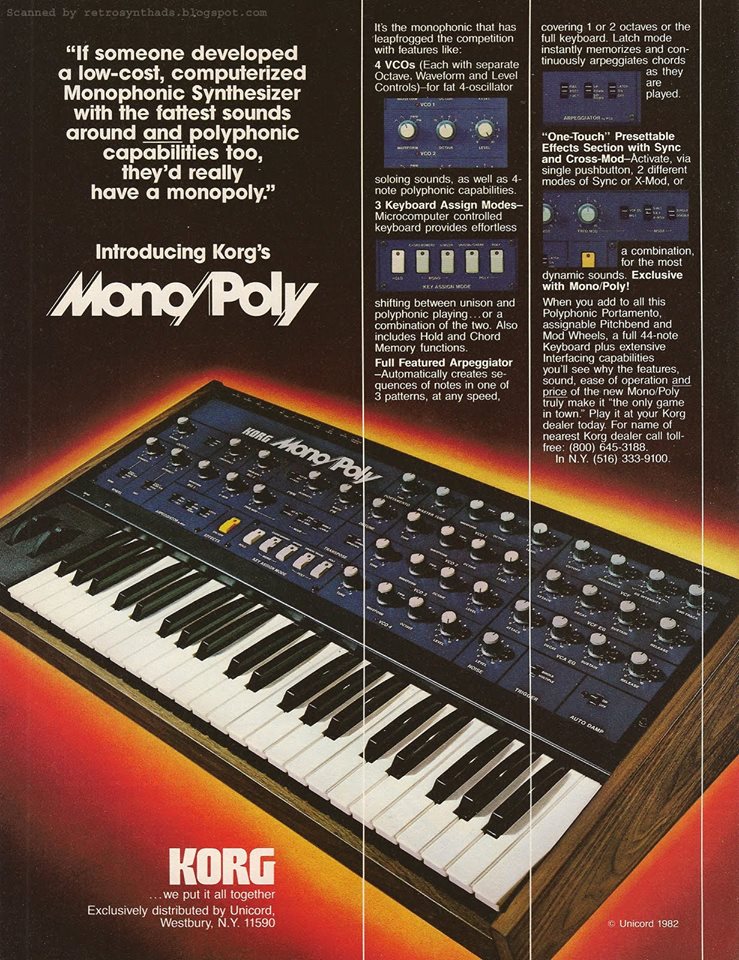
Usability
The main drawback of the Mono/Poly is that the 4 VCOs share one common VCA and VCF envelope, like all the knobby monophonic synthesizers like MiniMoog, but there are triggering and auto-dampering switches to compensate for the envelope sharing. This synth was not so much designed to be a polysynth like its sister the Polysix (which was manufactured at the same time), but more of an experimental synth with different footages and waveshapes per oscillator. The Mono/Poly also did not include a digital memory like its sister the Polysix, because its focus was again on experimentation.
Other drawbacks are the chipboard construction on the base and sides of the unit, which tend to get damaged easily or allow screws to come out, and the rubber contacts under the keyboard, which tend to wear over time resulting in dead keys; this may be fixed with a little cleaning and/or obtaining a new rubber strip, as Mono/Polys are fairly easy to disassemble. As far as circuit reliability, they tend to fare well by the standard of most analog synths. The most likely component to fail is generally one of the 4 VCOs (making its uselessness variable in POLY mode, depending on which oscillators have burned out); next to go is usually the filter. The VCOs and VCF are Solid State Micro Technology for Music(SSM) chips: (4 SSM2033 VCOs and 1 SSM2044 VCF, for replacement purposes).
The filter will self-oscillate (and blow an amplifier), but can also be scaled 1:1 with frequency so that the resonator can act as a 5th oscillator (sine wave). The frequency modulator in the ‘EFFECTS’ section can be used with the VCF envelope for pitch envelope control. A triangle wave can be used as a sub-oscillator to beef up the bass of the other oscillators: set a widespread chord in chord memory and then use the arpeggiator, and then switch back and forth between poly/chord memory.
The Mono/Poly can be used as a rhythm machine, by setting the instrument in ‘Poly’ and setting the different footages of the oscillators and the different waveshapes (triangle actually works best), and then using the ring modulator/frequency modulators with the Arpeggiator; adjust the envelopes accordingly to percussive settings and fiddle with the cut-off and noise from time to time to add tone color, and finally, set the LFO to pitch and set it at a considerable amplitude.
Further, the pedal inputs can be routed from synths like the Korg MS-20 so that external oscillators can further modulate above what’s already available. Because the VCOs have separate tuning controls they tend to be slightly out of tuning phase no matter how well they’re tuned; to play chords that are in direct tuning phase, play the notes in a rapid, descending order from high to low. Like most analog synthesizers, it tends to scale better from high to low than low to high.
The Mono/Poly is one of the vintage synthesizers reproduced by Korg for its software-based Legacy Collection. It can be used as a Virtual Studio Technology (VST) in common Digital audio workstations or as a stand-alone synth with any software compatible PC or Mac product.

